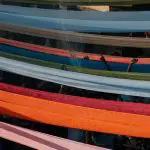Have you ever wondered if shea butter can stain your favorite fabrics?
The potential for shea butter to leave unwanted marks on your clothing or upholstery is a common concern. Understanding the composition of shea butter and the factors that contribute to its staining potential is crucial in managing this issue.
This guide will provide you with valuable insights into identifying, preventing, and removing shea butter stains from various fabrics. By mastering the knowledge and techniques outlined here, you can effectively address any potential staining concerns and continue to enjoy the benefits of shea butter without worrying about its impact on your fabrics.
Key Takeaways
- Shea butter has a high oil content, which can leave greasy stains on fabrics.
- Different fabric types have varying levels of absorbency and reaction to oils like shea butter.
- Fabrics with a looser weave or texture may trap shea butter more easily, leading to potential staining.
- Tightly woven fabrics may repel shea butter, making it easier to remove stains.
Understanding Shea Butter Composition
When using shea butter, you should understand its composition to prevent potential fabric staining. Shea butter is a natural fat extracted from the nut of the African shea tree. It's rich in fatty acids, vitamins, and minerals, making it a popular ingredient in skincare products.
The properties of shea butter that make it beneficial for the skin, such as its moisturizing and nourishing qualities, can also lead to potential staining of fabrics if not used and treated properly.
To prevent fabric staining when using shea butter, it's important to be aware of its properties. Shea butter has a high oil content, which can leave greasy stains on fabrics if not addressed promptly. When shea butter comes into contact with fabrics, it can create a stubborn stain that requires specific removal techniques.
To remove shea butter stains from fabrics, it's recommended to gently scrape off any excess butter, then treat the stained area with a pre-wash stain remover or a mixture of dish soap and hydrogen peroxide before laundering as usual.
Understanding the composition of shea butter and being familiar with effective stain removal techniques can help you avoid potential fabric staining and make the most of this beneficial natural ingredient.
Factors Affecting Staining Potential
When it comes to the potential of shea butter to stain your fabrics, several factors come into play.
The type and texture of the fabric, as well as the method of application and absorption, can significantly influence the likelihood of staining.
Understanding these factors will help you take the necessary precautions to prevent any unwanted discoloration on your fabrics.
Fabric Type and Texture
Consider the fabric type and texture when determining the potential for shea butter to stain your fabrics. Different fabric types, such as cotton, silk, wool, and synthetic fibers, have varying levels of absorbency and reaction to oils like shea butter.
Fabrics with a looser weave or texture, such as knits or terry cloth, may trap shea butter more easily, leading to potential staining. On the other hand, tightly woven fabrics like satin or tightly knit polyester may repel shea butter, making it easier to remove any accidental stains.
Understanding the fabric care recommendations for each specific type of fabric can guide you in preventing and addressing shea butter stains effectively.
When it comes to stain removal, the texture of the fabric can affect the success of various stain removal techniques.
Application and Absorption
To assess the potential for shea butter to stain your fabrics, consider how the application and absorption of shea butter are influenced by the fabric type and texture.
The application methods of shea butter, such as rubbing or patting, can affect its distribution on the fabric.
Additionally, the absorption rate of shea butter varies depending on the fabric's composition and weave. For instance, tightly woven fabrics may prevent shea butter from being absorbed quickly, leading to a higher likelihood of staining.
On the other hand, more porous fabrics might readily absorb shea butter, potentially causing deeper stains.
Understanding the interaction between shea butter and different fabric types is crucial in determining the potential for staining.
Identifying Fabric Stains
You should always inspect your fabrics carefully to identify any stains, as even a small amount of shea butter can leave noticeable marks. To help you in this process, consider the following:
- Vigilance: Regularly check your fabrics for any stains, especially after using products like shea butter.
- Lighting: Examine fabrics in good lighting to spot even the faintest of stains.
- Quick Action: Act promptly when you identify a stain to prevent it from setting into the fabric.
- Testing: Before using any stain removal technique, test it on a small, inconspicuous area of the fabric.
- Professional Help: If you're unsure about how to remove a stain or if the fabric is delicate, seek advice from a professional cleaner.
Identifying fabric stains early is crucial in preventing them from becoming permanent. By being proactive, you can protect your fabrics from the potential discoloration caused by substances like shea butter. Regular inspection and swift action can help maintain the quality of your fabrics and keep them looking their best.
Preventing Shea Butter Stains
To prevent shea butter stains on your fabrics, consider applying a fabric protector to create a barrier against potential stains.
When washing stained fabrics, use a gentle detergent and cold water to help lift the shea butter without setting the stain.
Additionally, store shea butter products in a cool, dry place away from direct sunlight to prevent them from melting and causing stains.
Fabric Protection Tips
When applying shea butter to your fabrics, carefully consider using a protective barrier such as a cloth or towel to prevent staining. To further safeguard your fabrics, here are some fabric protection tips to prevent shea butter stains:
- Promptly blot any shea butter spills with a clean cloth to prevent the oil from setting into the fabric.
- Consider using a fabric protector spray designed to repel oils and liquids to create a barrier against shea butter stains.
- Regularly wash and treat your fabrics with a high-quality fabric protector to maintain their resistance to shea butter stains.
- Avoid rubbing the shea butter into the fabric, as this can exacerbate the staining.
- Be mindful of the fabric type and follow the manufacturer's care instructions to ensure proper maintenance and protection against shea butter stains.
Washing Stained Fabrics
After spilling shea butter on your fabrics, it's essential to promptly address the stain to prevent it from setting in.
Start by gently scraping off any excess shea butter using a blunt knife or spoon.
Then, apply a small amount of gentle dish soap or laundry detergent directly to the stained area, and gently work it into the fabric with your fingers.
Let it sit for 5-10 minutes to allow the soap to penetrate the stain.
After that, launder the fabric as usual, following the care instructions on the garment's label.
Use the hottest water temperature recommended for the fabric, and check the stain before drying.
If the stain persists, repeat the pre-treating and washing process before drying, as heat can set in the stain.
Always remember to air dry the fabric if the stain is still visible, as heat from the dryer can make the stain more difficult to remove.
Storing Shea Butter
Ensure proper storage of shea butter to prevent potential fabric stains.
- Storing Tips: Store shea butter in a cool, dark place away from direct sunlight and heat sources to maintain its quality.
- Shelf Life: Check the expiration date and use shea butter within its shelf life to prevent rancidity and potential fabric stains.
- Shea Butter Properties: Consider the consistency of shea butter and choose a suitable container to prevent leakage and stains.
- Fabric Compatibility: Be mindful of the fabric type when using shea butter, as some fabrics are more prone to staining.
- Absorption Rate: Allow shea butter to fully absorb into the skin before coming into contact with fabrics to minimize potential stains.
Following these storing tips can help prevent shea butter stains on your fabrics, ensuring longevity and cleanliness.
Removing Shea Butter Stains
To effectively remove shea butter stains from your fabrics, start by using a gentle detergent and warm water. Begin by gently scraping off any excess shea butter from the fabric using a dull knife or spoon. Be careful not to spread the stain further into the fabric. After this, blot the stained area with a clean cloth to absorb as much of the remaining shea butter as possible. Then, apply a small amount of gentle detergent directly to the stain and gently rub it in with your fingers. Let the detergent sit on the fabric for a few minutes to penetrate the stain.
Next, wash the fabric in warm water, following the care instructions on the garment's label. Check the fabric before drying to ensure the stain has been completely removed. If the stain persists, repeat the process or consider using a stain remover specifically formulated for oil-based stains.
Once the shea butter stain has been completely removed, allow the fabric to air dry or follow the garment's care label instructions for drying. Proper stain removal techniques and fabric care are essential for maintaining the quality of your fabrics when dealing with shea butter stains.
Conclusion and Final Tips
You should always test a small, inconspicuous area of the fabric before attempting to remove shea butter stains using any method. This will help you determine the best approach for your specific fabric and avoid causing further damage.
In conclusion, when it comes to preventing stains and caring for your fabrics, consider the following tips:
- Regularly apply a fabric protector spray to create a barrier against stains
- Promptly blot spills and stains with a clean cloth to prevent them from setting into the fabric
- Avoid rubbing or scrubbing vigorously, as this can spread the stain and damage the fabric fibers
- Follow the care instructions on your fabric's label to ensure you're using the appropriate cleaning methods and products
- Consider seeking professional help for tough stains or delicate fabrics
Taking proactive measures to protect your fabrics and promptly addressing stains can help maintain their quality and appearance. By being mindful of fabric care and implementing preventative measures, you can minimize the risk of shea butter stains and other blemishes on your fabrics.
Frequently Asked Questions
Can Shea Butter Cause Allergic Reactions When It Comes Into Contact With Fabrics?
When coming into contact with fabrics, shea butter can cause allergic reactions if you have sensitive skin. To minimize stains, promptly wash affected fabrics with warm water and mild soap. Always spot-test on a small, inconspicuous area first.
Does the Color of the Shea Butter Affect Its Staining Potential on Different Fabrics?
The color of shea butter can affect its staining potential on different fabrics. Darker shea butter may have a higher potential for staining compared to lighter shades, especially when exposed to sunlight and when the fabric has high shea butter absorption.
Are There Any Specific Fabrics That Are More Prone to Staining From Shea Butter?
Certain fabrics, such as silk and satin, are more prone to staining from shea butter due to their delicate nature. It is important to handle shea butter with care when using it on these types of fabrics.
Can Shea Butter Leave a Residue on Fabrics Even After Washing?
Yes, shea butter can leave a residue on fabrics even after washing. To prevent this, consider using shea butter alternatives or spot-treating the fabric before washing. Following proper fabric care and laundry methods can help preserve your fabrics.
Is There a Specific Temperature or Method for Washing Fabrics to Remove Shea Butter Stains Effectively?
For the best washing techniques to remove shea butter stains effectively, use warm water and a gentle detergent. Wash the fabric in the recommended temperature, and allow it to air dry. Avoid hot water and vigorous scrubbing to prevent further staining.
- Fabrics and Their Role in Wellness and Comfort - July 22, 2024
- Choosing Safe Fabrics for Baby Clothes - July 22, 2024
- Impact of Fabrics on Skin Health - July 22, 2024






